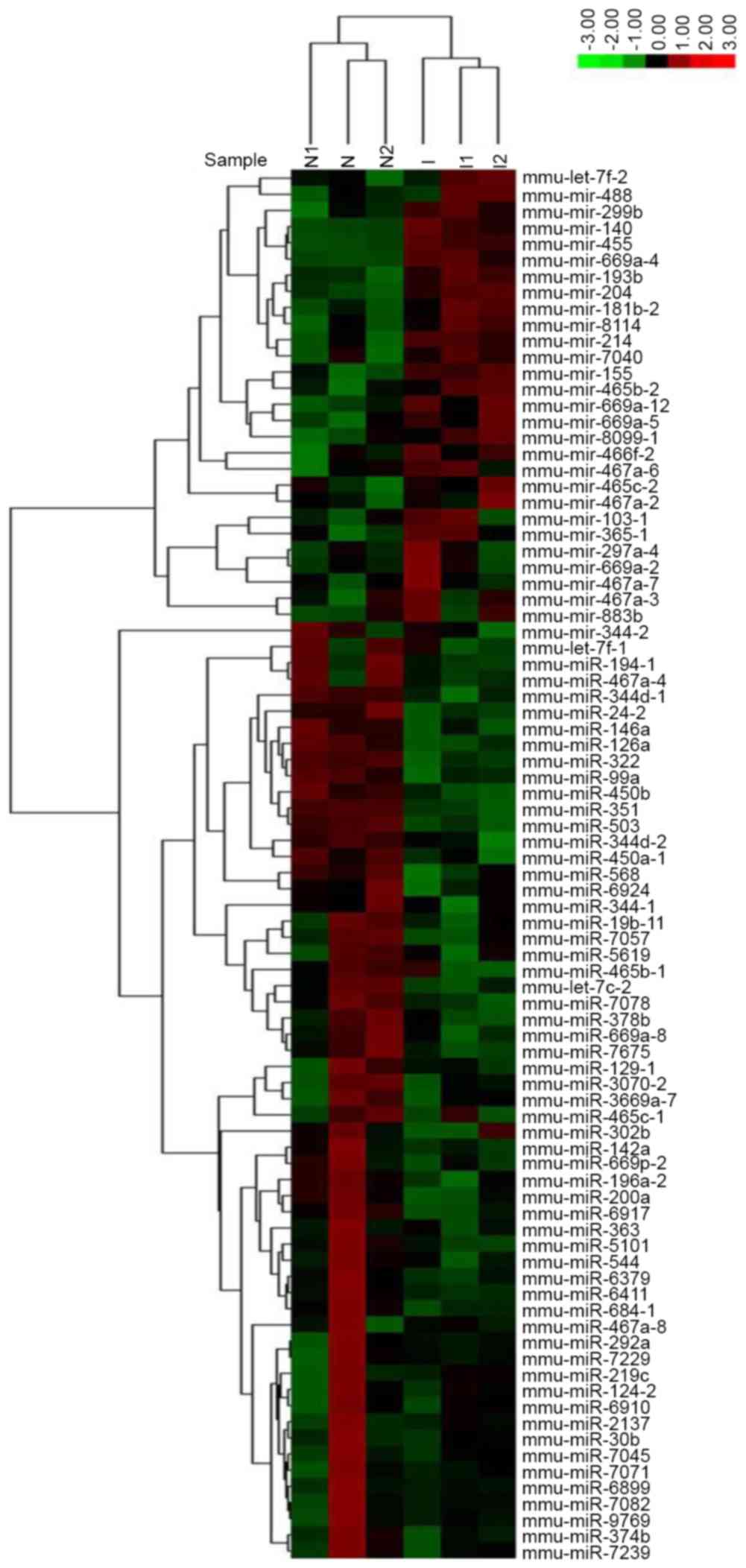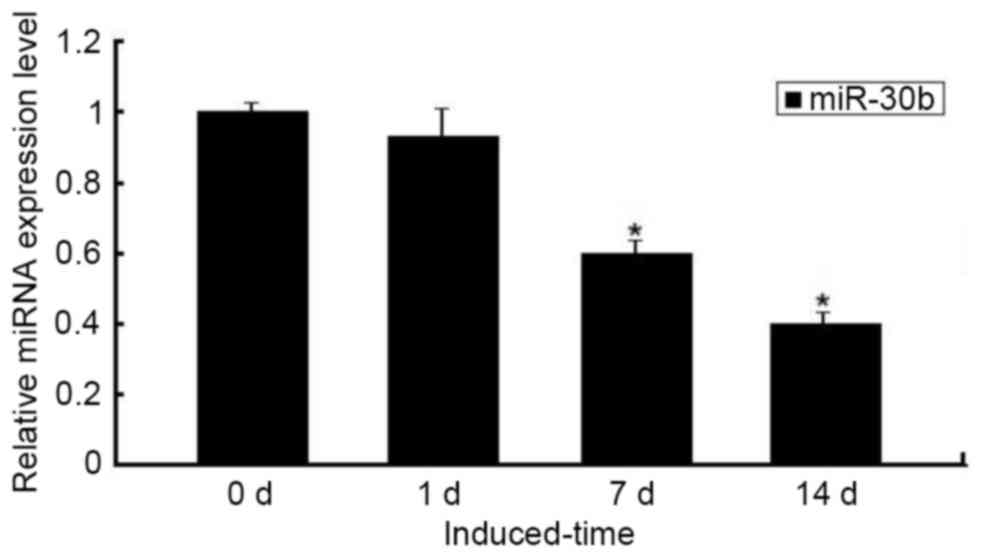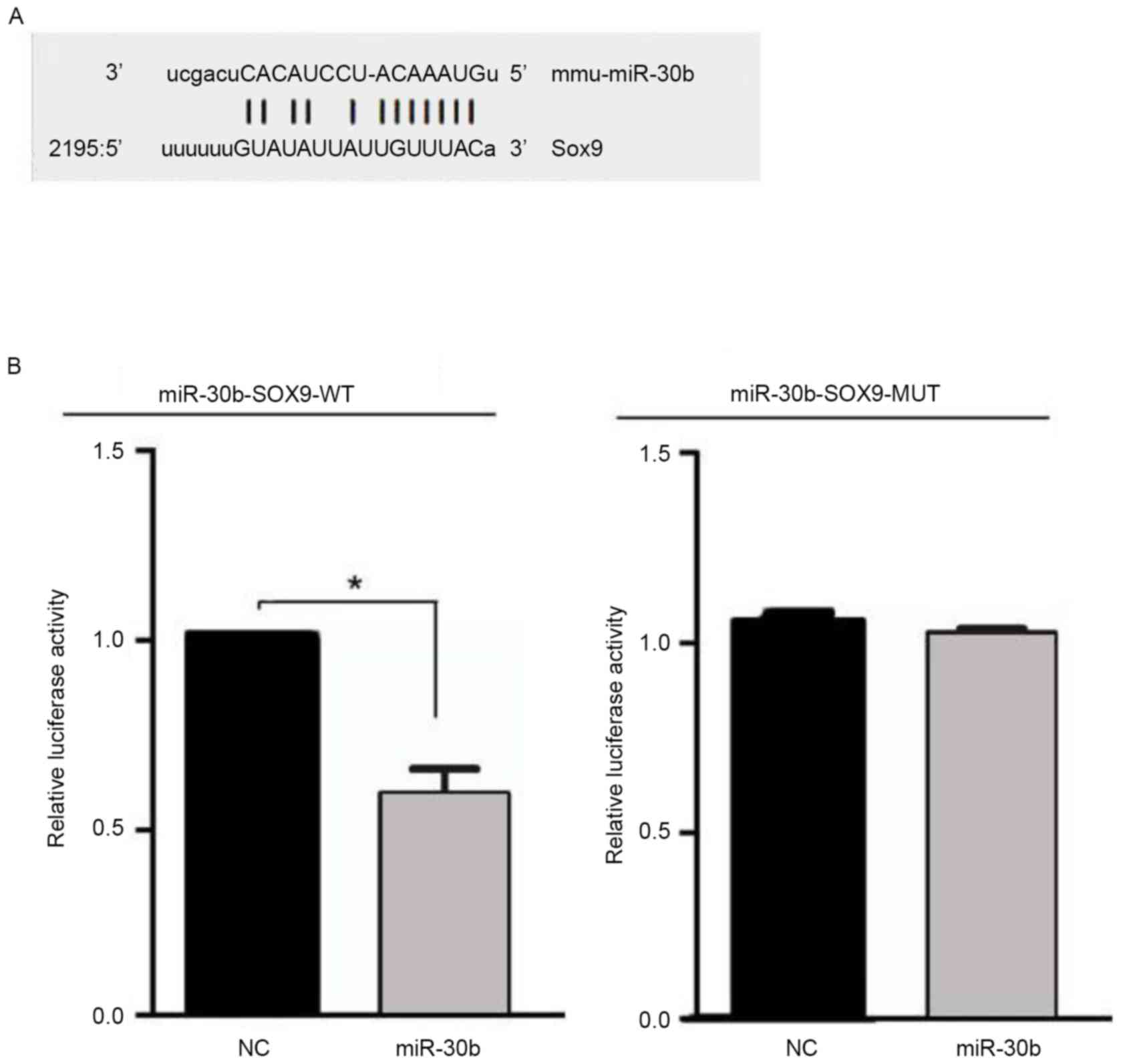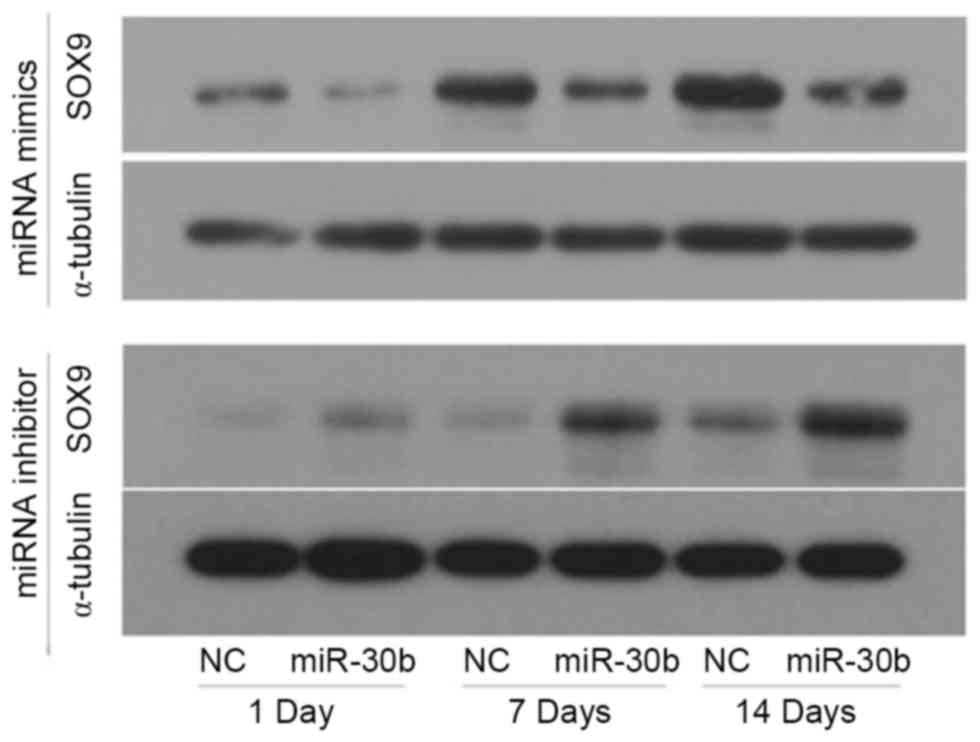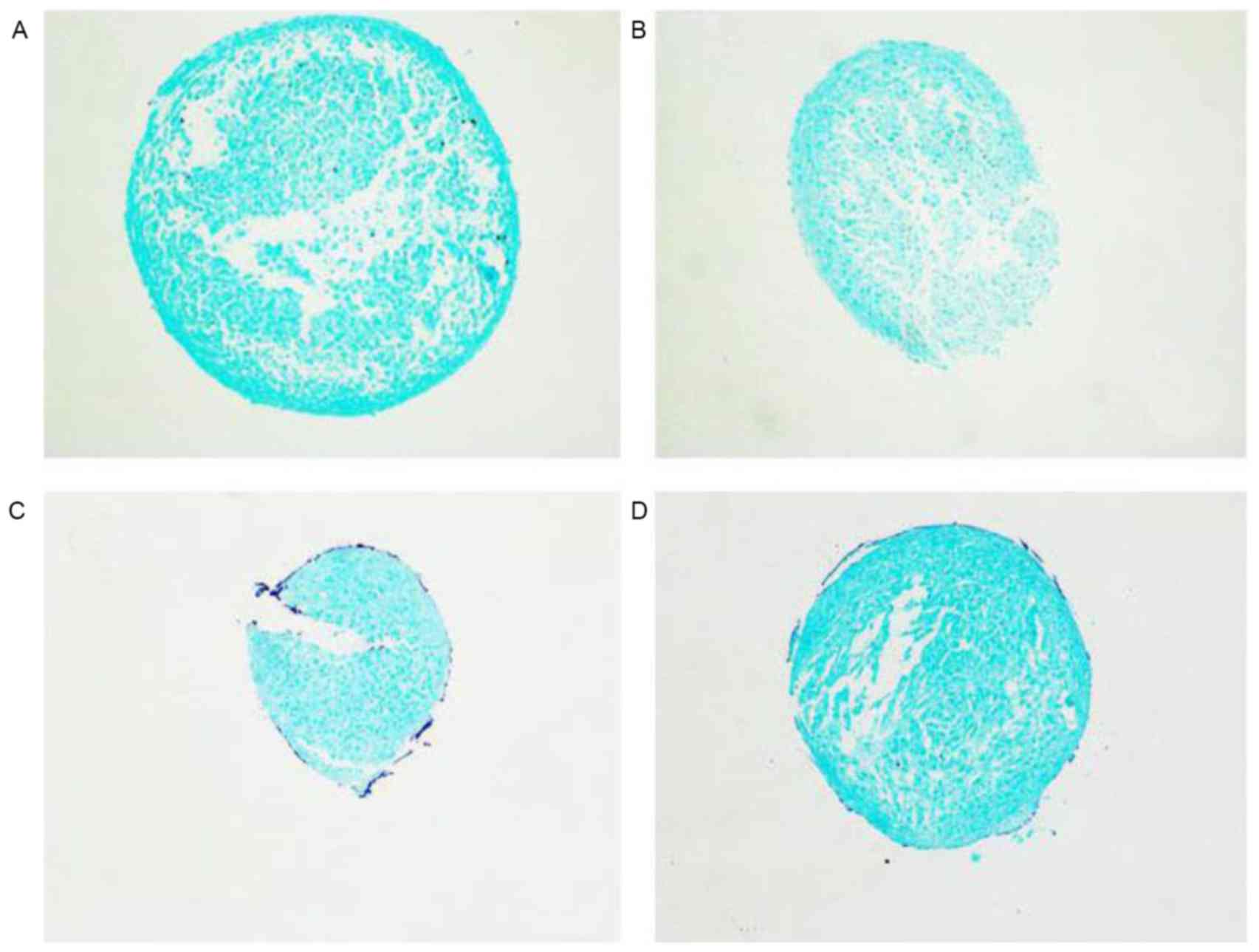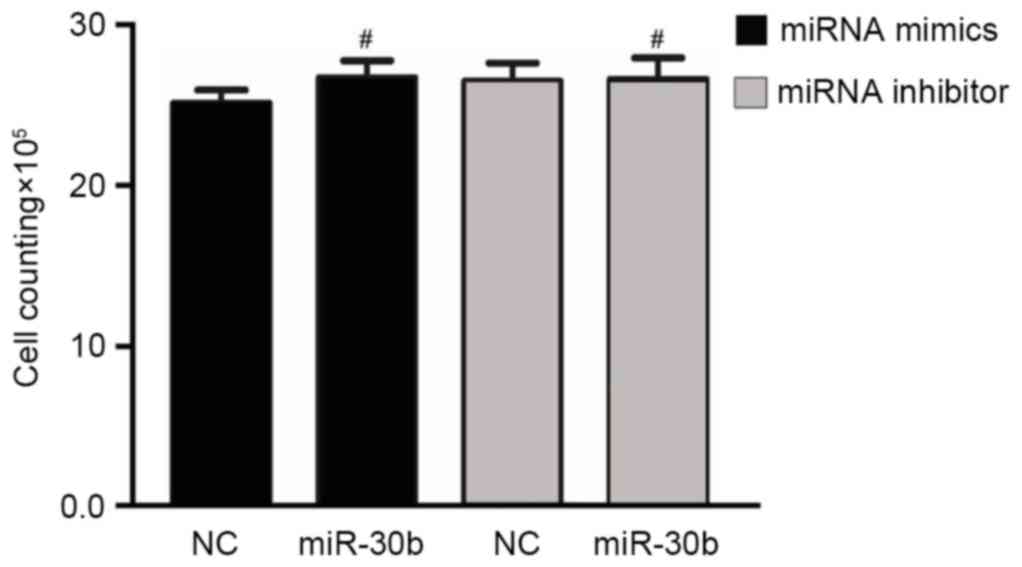miR-30b regulates chondrogenic differentiation of mouse embryo‑derived stem cells by targeting SOX9
- Authors:
- Published online on: October 18, 2017 https://doi.org/10.3892/etm.2017.5344
- Pages: 6131-6137
Abstract
Introduction
Cartilage defects seriously affect articulation, and without their self-restoration capability even a minor cartilage defect may be difficult to repair (1). In addition, articular cartilage defect repair remains a big problem. Although some progress has been made, current treatment options, including articular debridement, Pridie drilling technique, microfracture surgery, tissue engineered cartilage repair and periosteum, perichondrium, osteochondral and cell transplantation are not of high quality due to poor efficacy, high cost and limited resources, thus longer dated curative effects remain to be found (2–6). The development of new biological materials may assistant effective cartilage repair, however, in order to improve our understanding of cartilage material bioactive function, a selection of ideal seed cells and the promotion of cell chondrogenic differentiation are particularly important (7,8).
Mesenchymal stem cells (MSCs) with self-renewal, pluripotency and lower immunogenicity are considered to be ideal biological material as seed cells (9). One type of MSC derived from mouse embryos is the C3H10T1/2 cell line that has widely been used in studies that concentrate on the differentiation and regulation of stem cells (10–13).
MicroRNAs (miRNAs) are small non-coding (~22-nucleotide) RNAs that exist in eukaryotes. The biological functions of miRNA are diverse. For example, one miRNA can control a number of different target genes and there are also several miRNAs that together control one target gene (1). As a peculiar and endogenous small molecule, miRNA has become a powerful tool in the field of genetic engineering. Increasingly, studies indicate that miRNAs reveal stem cell fate and regulation patterns of epigenetics in biological behavior (2,3,14–17).
In the present study, miRNAs that significantly changed during the differentiation of C3H10T1/2 cells toward chondrocytes were screened. One of these was a novel miRNA, miR-30b, whose expression was significantly decreased during chondrogenic differentiation. The present study revealed that miR-30b inhibited the differentiation of C3H10T1/2 cells towards chondrocytes by modulating its expression, which indicates a possible negative feedback loop. Furthermore, SOX9 was verified as a direct target gene of miR-30b. Finally, the results of the present study confirmed a previously uncharacterized function for miR-30b as an inhibitor of chondrogenic differentiation.
Materials and methods
Cell culture
The mouse embryo-derived stem cells C3H10T1/2 were purchased from American Type Culture Collection (Manassas, VA, USA). C3H10T1/2 cells were cultured in low glucose Dulbecco's modified Eagle's medium (DMEM; Thermo Fisher Scientific, Inc., Waltham, MA, USA) supplemented with 10% fetal bovine serum (FBS; Thermo Fisher Scientific, Inc.) and incubated in a 5% CO2 incubator at 37°C. Cells were then passaged until a 90% confluence level was reached. The seventh generation cells were then used for establishing the pellet models of chondrogenic differentiation in vitro. For chondrogenic differentiation, C3H10T1/2 cells were cultured in pellets (2.5×105 cells/ml), and the culture medium was replaced every 2–3 days. Pellet models were then divided into a non-induced and an induced group. The pellets in the non-induced group were treated with non-induced solution (500 ml high-glucose DMEM with 20% FBS) while those in the induced group were treated with cartilage-induced solution (500 ml high-glucose DMEM with 5 µg transforming growth factor-β3 (TGF-β3) (Thermo Fisher Scientific, Inc.), 0.15 g vitamin C, 50 µl dexamethasone, 0.5 ml Insulin/Transferrin/Selenium solution and 20% FBS).
microRNA (miRNA) array analysis
Total RNA of the induced and non-induced groups of chondrogenic differentiation models were cultured from C3H10T1/2 for 14 days in vitro, including miRNAs. These were extracted using TRIzol reagent (Invitrogen; Thermo Fisher Scientific, Inc.) following the manufacturer's protocol. NanoDrop® ND-1000 (Thermo Fisher Scientific, Inc.,) was used to validate the overall quality of the total RNA and the RNAs that passed were used to construct small RNA libraries using a TruSeq small RNA sample preparation kit (Illumina Inc., San Diego, CA, USA). In addition, the quality and fragment size of the small RNA libraries were detected using Qubit 2.0 (Thermo Fisher Scientific, Inc.,) and BioAnalyzer 2100 (Agilent Technologies, Inc., Santa Clara, CA, USA), respectively. Subsequently, HiSeq 2500 (Illumina Inc.) was performed to sequence the library and the sequencing results were eventually confirmed by quantitative polymerase chain reaction (qPCR). Following the quality control the original sequencing data was pretreated by trim_galore (v0.3.3; Babraham Bioinformatics, Babraham Institute, Cambridge, UK). The expression pattern of small RNAs was statistically analyzed, classified and annotated further. In addition, clustering analysis was performed to classify the differentially expressed miRNAs between induced and non-induced groups using a TruSeq SR Cluster Generation kit (cat no. GD-300-2001, Illumina Inc.).
qPCR analysis
qPCR was performed to confirm the expression pattern of miR-30b, which emerged in the microarray results and U6 was used as an internal control. The total RNA was extracted from cell lines using TRIzol reagent (Invitrogen; Thermo Fisher Scientific, Inc.) following the manufacturer's protocol. Next, cDNA was generated from total RNA using a qPCR detection kit (Takara Bio, Inc., Otsu, Japan) according to manufacturer's protocol. Subsequently, the cDNA was analyzed by qPCR using the following amplification parameters: 95°C for 10 min, followed by 40 cycles of 95°C for 10 sec and 60°C for 60 sec. All the primers were designed by Shanghai Sangon Biotech Co., Ltd. (Shanghai, China). The primers of qPCR were as follows: U6, 5′CGC TTC ACG AAT TTG CGT GTC AT3′ and miR-30b, 5′GTC GTA TCC AGT GCA GGG TCC GAG GTA TTC GCA CTG GAT ACG ACA GCT GA3′.
The primers of qPCR are as follows: U6, forward, 5′GCT TCG GCA GCA CAT ATA CTA AAA T3′and U6, reverse, 5′CGC TTC ACG AAT TTG CGT GTC AT3′ and miR-30b, forward, 5′GCG GCG GTG TAA ACA TCC TAC AC3′ and miR-30b, reverse, 5′ATC CAG TGC AGG GTC CGA GG3′. The 2−ΔΔCq method was used for the quantification of gene expression (18).
Plasmid construction and dual-luciferase reporter assays
Bioinformatics software (http://www.targetscan.org and http://www.microrna.org) was used to predict the target gene of miR-30b and results suggested that SOX9 was a potential target of miR-30b. To confirm the prediction, miR-30b-SOX9-WT 3′untranslated region (UTR) was amplified using a 2X PCR Master mix (Fermentas; Thermo Fisher Scientific, Inc.) and cloned into the psiCHECK-2 reporter plasmid (Shanghai Sangon Biotech Co., Ltd.) using primers carrying restriction sites for XhoI and NotI. Mutated miR-30b-SOX9 3′UTR was generated by mutating the miR-30b seed sequence. The primers used were as follows: SOX9-WT, forward, 5′-CCGCTCGAGACAAACTGGAAACCTGTCTCTC-3′ and SOX9-WT, reverse, 5′-ATTTGCGGCCGCTTAATGCAATGTATATTTATTGTAAACAATAATATACAA3′ and SOX9-MUT, forward, 5′-CCGCTCGAGACAAACTGGAAACCTGTCTCTC-3′ and SOX9-MUT, reverse, 5′-TTTGCGGCCGCTTAATGCAATGTATATTTATTCATATCTATAATATACAAAAAAGAAAG-3′. In addition, the luciferase activity was assessed after transfection of C3H10T1/2 cells using the dual-luciferase reporter assay system (Promega Corporation, Madison, WI, USA) using the pMIRREPORT luciferase reporter according to the manufacturer's protocol. The luciferase activity was expressed as the mean ratio of firefly luciferase to Renilla luciferase activity.
Cell transfection
To investigate the function of miR-30b, miR-30b mimics, miR-30b inhibitor (600 pmol) or their negative controls were transfected into C3H10T1/2 cells with 30 µl Lipofectamine 2000 transfection reagent (Invitrogen; Thermo Fisher Scientific Inc.) following the manufacturer's protocol. Following incubation for 24 h, the transfected cells were used for chondrogenic differentiation analysis, and cells were harvested for protein analysis at on days 1, 7 and 14, respectively.
Western blot analysis
Radioimmunoprecipitation assay lysis buffer (50 mM Tris-Cl (pH 7.4), 150 mM NaCl, 1% Triton X-100, 0.1% SDS and 1% sodium deoxycholate) was used to lyse the micromass cultured C3H10T1/2 cells transfected with miR-30b mimics or miR-30b inhibitor for SDS-PAGE analysis. The protein concentration was measured using a bicinchoninic acid assay protein quantitative kit (Thermo Fisher Scientific, Inc.) and protein samples were mixed with 5X loading buffer (in a 1:4 ratio) and boiled for 6 min. The protein samples (25 µg) were then resolved on a 12% SDS-PAGE gel and transferred onto a polyvinylidene fluoride membrane (EMD Millipore, Billerica, MA, USA). They were then incubated with a primary antibody against SOX9 (anti-SOX9 antibody; cat no. Ab3697; dilution: 1:1,000) or α-tubulin (anti-α-tubulin antibody; cat no. Ab4074; dilution: 1:2,000) at 4°C overnight followed by incubation with an horse radish peroxidase-conjugated secondary antibody (anti-Rabbit immunoglobulin G VHH Single Domain, cat no. Ab191866; dilution: 1:5,000; all Abcam, Cambridge, UK) at room temperature for 1 h. α-tubulin was used as an internal control. Following washing with Tris-buffered saline and Tween-20, enhanced chemiluminescence was used for detection and they were developed using X-ray film, The ImageTool version 3.0 gray-scale scanning software (Microsoft Corporation, Redmond, WA, USA) was used to quantify band density.
Alcian blue stain
To detect the deposition of cartilage matrix proteoglycans, cells were collected on day 7 of induction and Alcian blue staining was performed to measure sulfated cartilage glycosaminoglycans. The pellets for Alcian blue staining were fixed by 4% paraformaldehyde for 20 min, then dehydrated and paraffin imbedded. Next, 4 µm sections were stained by 0.5% alcian blue 8GX (Merck KGaA, Darmstadt, Germany) for 10 min.
Cell proliferation assay
The proliferation of C3H10T1/2 cells was detected by directly counting cell numbers. miR-30b mimics, miR-30b inhibitor and their negative controls were transfected into C3H10T1/2 cells for 48 h. Subsequently, the transfected cells were trypsinized using 0.25% trypsin and directly counted using an automated cell counter. Each group repeated counting in triplicate.
Statistical analysis
SPSS 17.0 statistical software (SPSS, Chicago, IL, United States) was used for all statistical analyses. Data are expressed as the mean ± standard deviation. Statistical comparisons were made between the two groups with the t-test and between multiple groups with one-way analysis of variance. P<0.05 was used to indicate a statistically significant difference.
Results
miR-30b is downregulated in C3H10T1/2 cells during TGF-β3-induced chondrogenic differentiation
In the present study, miRNA microarray technology was applied to screen the upregulated and downregulated miRNAs during in vitro chondrogenic differentiation of C3H10T1/2 cells. Clustering analysis was performed to classify the differentially expressed miRNAs between the induced and non-induced groups. A hierarchical clustering map demonstrated the differentially expressed miRNAs (Fig. 1). In addition, 86 miRNAs were identified that showed higher (28) or lower (58) expression in induced C3H10T1/2 cells compared to the non-induced cells. Among the differentially expressed miRNAs, miR-30b was significantly decreased during chondrogenic differentiation. Furthermore, the downregulated expression of miR-30b was confirmed by qPCR, which was significant on days 7–14 compared with day 0 (P<0.05; Fig. 2).
miR-30b targets SOX9 by binding 3′-UTR of SOX9 mRNA
miRNAs inhibit mRNA expression by binding the 3′-UTR of target mRNA. Combined with bioinformatics software (http://www.targetscan.org and http://www.microrna.org) and literature analysis, it was hypothesized that miR-30b may be combined with the SOX9 gene at the 3′-UTR nucleotide site. In order to determine whether miR-30b targets SOX9, a luciferase reporter gene assay was performed using the pMIRREPORT luciferase reporter. Next, the miR-30b-SOX9-WT or miR-30b-SOX9-MUT reporter plasmid was co-transfected into C3H10T1/2 cells with miR-30b or their negative control, and the results demonstrated that luciferase activity was significantly decreased in the C3H10T1/2 cells co-transfected with miR-30b with miR-30b-SOX9-WT, whereas no effect was observed following co-transfection of miR-30b with miR-30b-SOX9-MUT (Fig. 3). These data indicate that miR-30b inhibits expression of transcripts containing an miR-30b binding site.
miR-30b inhibits SOX9 expression during chondrogenic differentiation
To determine whether miR-30b acts as an inhibitor of SOX9 protein expression, C3H10T1/2 cells were transfected with miR-30b mimics, miR-30b inhibitor or their negative controls for 24 h, respectively, then induced by TGF-β3. Furthermore, the expression of SOX9 was detected using western blotting. Compared to the negative control, the protein level of SOX9 was notably decreased in the miR-30b mimics groups on day 1, 7 and 14, respectively, whereas it was increased in the miR-30b inhibitor groups (Fig. 4). Furthermore, the protein expression level of SOX9 increased in a time-dependent manner during chondrogenic differentiation. These results indicated that miR-30b is important in suppressing SOX9 protein expression during chondrogenic differentiation.
miR-30b inhibits early chondrogenic differentiation
miR-30b mimics, miR-30b inhibitor or their negative controls were transfected into C3H10T1/2 cells in order to investigate whether miR-30b exhibited an effect on chondrogenic differentiation. Alcian blue staining intensity was detected following the induction of chondrogenic differentiation by medium containing TGF-β3 for 7 days. The alcian blue staining intensity was decreased following miR-30b mimic treatment compared with the negative group. By contrast, the intensity of the miR-30b inhibitor treatment group was evidently enhanced (Fig. 5). Overall, the data of the present study demonstrated that miR-30b suppresses chondrogenic differentiation by affecting the secretion of characteristic cartilage in the extracellular matrix.
miR-30b has no influence on C3H10T1/2 cell line proliferation
In order to investigate the role of miR-30b in cell proliferation, a direct cell count method was performed to detect the proliferation of C3H10T1/2 cells. However, compared to the negative control group, treatment of C3H10T1/2 cells with either miR-30b mimics or miR-30b inhibitor did not significantly affect cell proliferation (Fig. 6).
Discussion
Based on our previous results (19), high-throughput sequencing chip technology was performed to investigate the expression of miR-30b during TGF-β3-induced chondrogenic differentiation. Furthermore, bioinformatics prediction and dual-luciferase reporter assays were performed to verify whether SOX9 was a target gene of miR-30b. However, due to false positive results that may appear in the dual-luciferase reporter assays, protein expression results are required in order to verify the results. In the present study, C3H10T1/2 cells were transfected with miR-30b mimics or miR-30b inhibitor and induced by TGF-β3. Furthermore, SOX9 protein expression was detected on day 1, 7 and 14 during the chondrogenic differentiation. Western blotting results demonstrated that overexpression of miR-30b resulted in significant reduction of SOX9 protein; on the other hand, inhibition of the expression of miR-30b demonstrated that SOX9 protein expression was increased. In addition, the SOX9 protein expression level increased in a time-dependent manner during the chondrogenic differentiation. The protein test results once again verified that SOX9 was a target of miR-30b.
miRNAs, a type of non-coding RNA, are 21–23 nucleotides in length and are a type of endogenous regulatory RNA. Large quantities of miRNA have been identified in a variety of organisms, and increasing numbers of studies of its function are being published. Currently, studies in China and abroad demonstrate that miRNAs are involved in numerous physiological and pathological processes, including cell development, cell differentiation, metabolism and cancer amongst others (20–24). Specific to the relevant regulation of miRNA for chondrogenic differentiation, research suggests that miRNA is involved in the regulation of the cartilage formation, cartilage differentiation phenotype maintenance and metabolism of chondrocytes (25–28). Furthermore, miRNA is important in cartilage formation, a complex regulatory process.
Initially, the target gene of miR-30b and the interaction site were identified. A dual luciferase reporter assay validated that miR-30b could recognize and interact with SOX9-3′UTR. Being the target gene of miR-130b, SOX9 is an important transcription factor of cartilage cell development and differentiation that contains the high-mobility-group DNA-binding domain (29). Previous studies have demonstrated that SOX9 binds to and activate several genes, including collagen type II alpha 1 chain, bone morphogenetic protein 2, aggrecan and cartilage-derived retinoic acid-sensitive protein amongst others (30–33). In addition, SOX9 is also important in different stages of growth and development. On the one hand it inhibits chondrocyte hypertrophy in advance while on the other hand it promotes normal chondrocyte hypertrophy. Next, the present study investigated whether SOX9 expression levels were affected by miR-30b activation/inhibition in TGF-β3-induced C3H10T1/2 MSCs. The results indicated that the protein levels of SOX9 evidently overexpressed miR-30b but were markedly increased when inhibiting miR-30b expression. Furthermore, the protein expression level of SOX9 increased with time extension during chondrogenic differentiation. These results indicated that miR-30b is important role in suppressing SOX9 protein expression during chondrogenic differentiation.
Furthermore, the proliferation of C3H10T1/2 cells was detected using a direct cell count method. The results demonstrated that there was no significant difference between the miR-30b overexpression and miR-30b inhibition groups compared with the negative control treatment group. At the same time, glycosaminoglycan synthesis was measured by alcian blue staining and the results revealed that, compared with the control group, miR-30b overexpression can reduce dyeing. On the contrary, when inhibited the expression of miR-30b dyeing can increase. The results indicate that miR-30b affects the secretion of characteristic cartilage in the extracellular matrix by directly targeting SOX9 during chondrogenic differentiation, but had no evident effect on cell proliferation. To the best of our knowledge the present study demonstrated for the first time that during chondrogenic differentiation induced by TGF-β3, miR-30b inhibited C3H10T1/2 MSC chondrogenic differentiation by targeting SOX9. However, no significant influence on C3H10T1/2 MSC proliferation was observed.
In conclusion, the results of the present study indicated that miR-30b was a key negative regulator of TGF-β3-induced chondrogenic differentiation by affecting the secretion of characteristic cartilage in the extracellular matrix and by directly targeting SOX9 at the early stage of chondrogenic differentiation. These results suggest that miR-30b may have potentially important therapeutic implications for cartilage regeneration.
Acknowledgements
The present study was supported by the National Key Basic Research and Development Program (973 Program; grant no. 2012CB619105).
References
|
He L and Hannon GJ: MicroRNAs: Small RNAs with a big role in gene regulation. Nat Rev Genet. 5:522–531. 2004. View Article : Google Scholar : PubMed/NCBI | |
|
Kanellopoulou C, Muljo SA, Kung AL, Ganesan S, Drapkin R, Jenuwein T, Livingston DM and Rajewsky K: Dicer-deficient mouse embryonic stem cells are defective in differentiation and centromeric silencing. Genes Dev. 19:489–501. 2005. View Article : Google Scholar : PubMed/NCBI | |
|
Luzi E, Marini F, Sala SC, Tognarini I, Galli G and Brandi ML: Osteogenic differentiation of human adipose tissue-derived stem cells is modulated by the miR-26a targeting of the SMAD1 transcription factor. J Bone Miner Res. 23:287–295. 2008. View Article : Google Scholar : PubMed/NCBI | |
|
Ansorge WJ: Next-generation DNA sequencing techniques. N Biotechnol. 25:195–203. 2009. View Article : Google Scholar : PubMed/NCBI | |
|
Wang Z, Gerstein M and Snyder M: RNA-Seq: A revolutionary tool for transcriptomics. Nat Rev Genet. 10:57–63. 2009. View Article : Google Scholar : PubMed/NCBI | |
|
Martin JA and Wang Z: Next-generation transcriptome assembly. Nat Rev Genet. 12:671–682. 2011. View Article : Google Scholar : PubMed/NCBI | |
|
Studer D, Millan C, Öztürk E, Maniura-Weber K and Zenobi-Wong M: Molecular and biophysical mechanisms regulating hypertrophic differentiation in chondrocytes and mesenchymal stem cells. Eur Cell Mater. 24:118–135. 2012. View Article : Google Scholar : PubMed/NCBI | |
|
Hsiao SH, Lee KD, Hsu CC, Tseng MJ, Jin VX, Sun WS, Hung YC, Yeh KT, Yan PS, Lai YY, et al: DNA methylation of the Trip10 promoter accelerates mesenchymal stem cell lineage determination. Biochem Biophys Res Commun. 400:305–12. 2010. View Article : Google Scholar : PubMed/NCBI | |
|
Xian CJ and Foster BK: Repair of injured articular and growth plate cartilage using mesenchymal stem cells and chondrogenic gene therapy. Curr Stem Cell Res Ther. 1:213–29. 2006. View Article : Google Scholar : PubMed/NCBI | |
|
Ji YH, Ji JL, Sun FY, Zeng YY, He XH, Zhao JX, Yu Y, Yu SH and Wu W: Quantitative proteomics analysis of chondrogenic differentiation of C3H10T1/2 mesenchymal stem cells by iTRAQ labeling coupled with on-line two-dimensional LC/MS/MS. Mol Cell Proteomics. 9:550–564. 2010. View Article : Google Scholar : PubMed/NCBI | |
|
Ji C, Liu X, Xu L, Yu T, Dong C and Luo J: RUNX1 plays an important role in mediating BMP9-Induced osteogenic differentiation of mesenchymal stem cells line C3H10T1/2, murine multi-lineage cells lines C2C12 and MEFs. Int J Mol Sci. 18:E13482017. View Article : Google Scholar : PubMed/NCBI | |
|
Son HE, Kim TH and Jang WG: Curculactones A and B induced the differentiation of C3H10T1/2 and MC3T3-E1 cells to osteoblasts. Bioorg Med Chem Lett. 27:1301–1303. 2017. View Article : Google Scholar : PubMed/NCBI | |
|
Hashimoto Y, Kobayashi M, Matsuzaki E, Higashi K, Takahashi-Yanaga F, Takano A, Hirata M and Nishimura F: Sphingosine-1-phosphate-enhanced Wnt5a promotes osteogenic differentiation in C3H10T1/2cells. Cell Biol Int. 40:1129–1136. 2016. View Article : Google Scholar : PubMed/NCBI | |
|
Megosh HB, Cox DN, Campbell C and Lin H: The role of PIWI and the miRNA machinery in drosophila germline determination. Curr Biol. 16:1884–1894. 2006. View Article : Google Scholar : PubMed/NCBI | |
|
Park JK, Liu X, Strauss TJ, McKearin DM and Liu Q: The miRNA pathway intrinsically controls self-renewal of drosophila germline stem cells. Curr Biol. 17:533–538. 2007. View Article : Google Scholar : PubMed/NCBI | |
|
Förstemann K, Tomari Y, Du T, Vagin VV, Denli AM, Bratu DP, Klattenhoff C, Theurkauf WE and Zamore PD: Normal microRNA maturation and germ-line stem cell maintenance requires loquacious, a double-stranded RNA-binding domain protein. PLoS Biol. 3:e2362005. View Article : Google Scholar : PubMed/NCBI | |
|
Wang Y, Medvid R, Melton C, Jaenisch R and Blelloch R: DGCR8 is essential for microRNA biogenesis and silencing of embryonic stem cell self-renewal. Nat Genet. 39:380–385. 2007. View Article : Google Scholar : PubMed/NCBI | |
|
Livak KJ and Schmittgen TD: Analysis of relative gene expression data using real-time quantitative PCR and the 2(-Delta Delta C(T)) method. Methods. 25:402–408. 2001. View Article : Google Scholar : PubMed/NCBI | |
|
Wa Q, Gao M, Dai X, Yu T, Zhou Z, Xu D and Zou X: Induction of chondrogenic differentiation of mouse embryonic mesenchymal stem cells through an in vitro pellet model. Cell Biol Int. 39:657–665. 2015. View Article : Google Scholar : PubMed/NCBI | |
|
Carmell MA, Girard A, van de Kant HJ, Bourc'his D, Bestor TH, de Rooij DG and Hannon GJ: MIWI2 is essential for spermatogenesis and repression of transposons in the mouse male germline. Dev Cell. 12:503–514. 2007. View Article : Google Scholar : PubMed/NCBI | |
|
Chen CZ, Li L, Lodish HF and Bartel DP: MicroRNAs modulate hematopoietic lineage differentiation. Science. 303:83–86. 2004. View Article : Google Scholar : PubMed/NCBI | |
|
Hornstein E, Mansfield JH, Yekta S, Hu JK, Harfe BD, McManus MT, Baskerville S, Bartel DP and Tabin CJ: The microRNA miR-196 acts upstream of Hoxb8 and Shh in limb development. Nature. 438:671–674. 2005. View Article : Google Scholar : PubMed/NCBI | |
|
Pfeffer S and Voinnet O: Viruses, microRNAs and cancer. Oncogene. 25:6211–6219. 2006. View Article : Google Scholar : PubMed/NCBI | |
|
Taft RJ, Pang KC, Mercer TR, Dinger M and Mattick JS: Non-coding RNAs: Regulators of disease. J Pathol. 220:126–139. 2010. View Article : Google Scholar : PubMed/NCBI | |
|
Fukumoto T, Sperling JW, Sanyal A, Fitzsimmons JS, Reinholz GG, Conover CA and O'Driscoll SW: Combined effects of insulin-like growth factor-1 and transforming growth factor-beta1 on periosteal mesenchymal cells during chondrogenesis in vitro. Osteoarthritis Cartilage. 11:55–64. 2003. View Article : Google Scholar : PubMed/NCBI | |
|
Schaefer JF, Millham ML, de Crombrugghe B and Buckbinder L: FGF signaling antagonizes cytokine-mediated repression of Sox9 in SW1353 chondrosarcoma cells. Osteoarthritis Cartilage. 11:233–241. 2003. View Article : Google Scholar : PubMed/NCBI | |
|
Murakami S, Kan M, McKeehan WL and de Crombrugghe B: Up-regulation of the chondrogenic Sox9 gene by fibroblast growth factors is mediated by the mitogen-activated protein kinase pathway. Proc Natl Acad Sci USA. 97:pp. 1113–1118. 2000, View Article : Google Scholar : PubMed/NCBI | |
|
Woods A and Beier F: RhoA/ROCK signaling regulates chondrogenesis in a context-dependent manner. J Biol Chem. 281:13134–13140. 2006. View Article : Google Scholar : PubMed/NCBI | |
|
Tamamura Y, Katsube K, Mera H, Itokazu M and Wakitani S: Irx3 and Bmp2 regulate mouse mesenchymal cell chondrogenic differentiation in both a Sox9-dependent and -independent manner. J Cell Physiol. 232:3317–3336. 2017. View Article : Google Scholar : PubMed/NCBI | |
|
Bridgewater LC, Lefebvre V and de Crombrugghe B: Chondrocyte-specific enhancer elements in the Col11a2 gene resemble the Col2a1 tissue-specific enhancer. J Biol Chem. 273:14998–15006. 1998. View Article : Google Scholar : PubMed/NCBI | |
|
Sekiya I, Tsuji K, Koopman P, Watanabe H, Yamada Y, Shinomiya K, Nifuji A and Noda M: SOX9 enhances aggrecan gene promoter/enhancer activity and is up-regulated by retinoic acid in a cartilage-derived cell line, TC6. J Biol Chem. 275:10738–10744. 2000. View Article : Google Scholar : PubMed/NCBI | |
|
Xie WF, Zhang X, Sakano S, Lefebvre V and Sandell LJ: Trans-activation of the mouse cartilage-derived retinoic acid-sensitive protein gene by Sox9. J Bone Miner Res. 14:757–763. 1999. View Article : Google Scholar : PubMed/NCBI | |
|
Sakou T: Bone morphogenetic proteins: From basic studies to clinical approaches. Bone. 22:591–603. 1998. View Article : Google Scholar : PubMed/NCBI |



